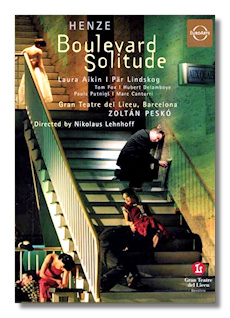
The Internet's Premier Classical Music Source
Related Links
- Latest Reviews
- More Reviews
-
By Composer
-
Collections
DVD & Blu-ray
Books
Concert Reviews
Articles/Interviews
Software
Audio
Search Amazon
Recommended Links
Site News
 DVD Review
DVD Review
Hans Werner Henze

Boulevard Solitude
- Laura Aikin (Manon Lescaut)
- Pär Lindskog (Armand Des Grieux)
- Tom Fox (Lescaut)
- Hubert Delamboye (Lilaque le père)
- Pauls Putninš (Lilaque le fils)
- Marc Canturri (Francis)
Cor de Cambra del Palau de la Música Catalana
Cor Vivaldi: Petits Cantors de Catalunya
Orquestra Simfònica del Gran Teatre del Liceu/Zoltán Peskó
EuroArts DVD 2056358 102min Dolby DTS Widescreen Anamorphic
François Prévost's story about pleasure-seeking Manon Lescaut and her all too devoted Chevalier des Grieux has been made into several operas and ballets. Hans Werner Henze's version from 1952 is based only indirectly on Prévost, as the composer's direct inspiration was a play by Walter Jockisch, and the 1949 film by Henri-Georges Clouzot. Pared back to its essentials, the outlines of the familiar story are still there, except it has been updated, and the central character is not Manon but Des Grieux. The Lulu-like Manon becomes a symbol for the destruction that awaits those who allow love to outrun common sense. The opera was Henze's first big success. In it, he mixes modern techniques of composition (twelve-tone writing, for example) with outbursts of distorted jazz. Because Henze uses twelve-tone writing for expressive purposes, rather than as a mere device, the score is pretty easy to swallow – no more difficult than Wozzeck and Lulu, for example. While there aren't tunes that one can take into the shower, the music's color and drama pull the listener along.
The plot is as follows: in a rail station, university student Armand des Grieux becomes immediately infatuated with Manon Lescaut, who is traveling to a finishing school in Lausanne. Together, they run off to Paris. They are followed by Lescaut, her elder brother. When des Grieux's money runs out, Lescaut sets Manon up with the elderly but rich Lilaque. Manon lives the high life with him, until Lescaut robs him, and they both are thrown out. In the meantime, des Grieux has returned to his studies, but Manon comes back and rekindles their relationship. Lescaut turns des Grieux into a cocaine addict, all the better to extract him from Manon, whom he now fixes up with Lilaque's son. Still in love with Des Grieux, Manon invites des Grieux to join her while her new lover is away, but once again Lescaut makes trouble for them by stealing a painting. The elder Lilaque bursts in, and after a struggle with Lescaut, Manon shoots Lilaque. In the final scene, Manon is sent to prison as des Grieux, now utterly alone, bewails her fate and his.
In Nikolaus Lehnhoff's production, which originally was created for the Royal Opera House in London, the opening rail station becomes a theme for the entire opera. Through clever, evocative lighting, and the shifting of a few scenic elements, the waiting room can become des Grieux's flat, Lilaque's home, the university library, and so on. In the transitions between scenes, the waiting room returns, and the bustle of passengers is repeated over and over again. The setting is appropriate, because waiting rooms in rail stations are impersonal and impermanent places, and because sometimes waiting for the one love that will transform one's life is like waiting for a train: we don't if it will be on time, late, or cancelled entirely.
The singing and acting are very effective in this production. Lindskog, who was a great Števa in Barcelona's Jenofa (TDK DVWW-OPJENU) is plausibly an overgrown, under-confident boy, and has a reedy, Vickers-like voice. Although sometimes he is covered by the orchestra, most of the time he is able to project, and he handily conveys the role's passion and despair. Aikin is an accomplished Lulu, and one feels that her Manon Lescaut comes from exactly the same bottle… a very frigid bottle, I might add. As her brother-cum-pimp, Tom Fox is one part charm and one part disreputability. Hubert Delamboye is florid and grotesque as father Lilaque, and handsome Pauls Putninš is quietly sinister as the son. In the small role of fellow student Francis, Marc Canturri makes a positive impression. Veteran conductor Zoltán Peskó finds both the brutality and the delicacy in Henze's orchestral writing.
The camera-work and sound are among the very best. Operas at the Liceu in Barcelona don't always feature top-name singers, but from what I've seen, the productions in toto are the equal of those at any opera house you care to name. Three performances in March 2007 were used to create this very worthwhile DVD.
Copyright © 2008, Raymond Tuttle




















